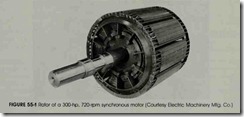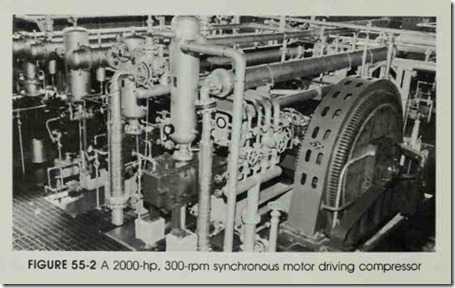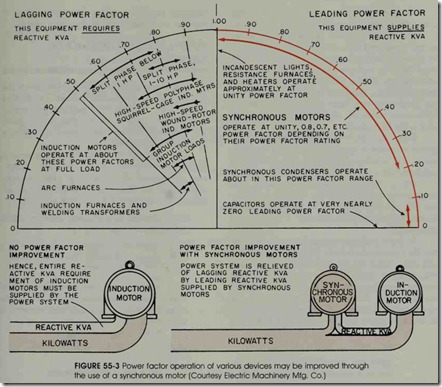Objectives
After studying this unit, the student will be able to:
• Describe the operation and applications of a synchronous motor
• Describe lagging and leading power factor and the causes of each
• Describe how the use of a synchronous motor improves the efficiency of an electrical system having a lagging power factor Identify a brushless synchronous motor
One of the distinguishing features of the syn chronous motor is that it runs without slip at a speed determined by the frequency of the con nected power source and the number of poles it contains. This type of motor sets up a rotating field through stator coils energized by alternating current. (This action is similar to the principle of an induction motor.) An independent field is established by a rotor energized by direct current through slip rings mounted on the shaft. The ro tor has the same number of coils as the stator. At running speed, these fields (north and south) lock into one another magnetically so that the speed of the rotor is in step with the rotating magnetic field of the stator. In other words, the rotor turns at the synchronous speed. Variations in the connected load do not cause a corresponding change in speed, as they would with the induction motor.
The rotor, figure 55-1, is excited by a source of direct current so that it produces alternate north and south poles. These poles are then at tracted by the rotating magnetic field in the stator. The rotor must have the same number of poles as the stator winding. Every rotor pole, north and south, has an alternate stator pole, south and north, with which it can synchronize.
The rotor has de field windings to which direct current is supplied through collector rings (slip rings). The current is provided from either an external source or a small de generator con nected to the end of the rotor shaft.
The magnetic fields of the rotor poles are locked into step with-and pulled around by-the revolving field of the stator. Assuming that the ro tor and stator have the same number of poles, the rotor moves at the stator frequency (in hertz) ac tually produced by the generator supplying the motor.
Synchronous motors are constructed almost exactly like alternators. They differ only in those features of design that may make the motor better adapted to its particular purpose.
A synchronous motor cannot start without help because the de rotor poles at rest are alter nately attracted and repelled by the revolving sta tor field. Therefore, an induction squirrel cage, or starting, winding is embedded in the pole faces of the rotor. This is called an amortisseur (ah-more-ti sir) winding.
This starting winding resembles a squirrel cage winding. The induction effect of the starting winding provides the starting, accelerating, and pull-up torques required. The winding is designed to be used only for starting and for damping oscil lations during running. It cannot be used like the winding of the conventional squirrel cage motor. It has a relatively small cross-sectional area and will overheat if the motor is used as a squirrel cage induction motor.
The slip is equal to 100 percent at the mo ment of starting. Thus, when the ac rotating mag netic field of the stator cuts the rotor windings, which are stationary at startup, the induced volt ages produced may be high enough to damage the insulation if precautions are not taken.
If the de rotor field is either connected as a closed circuit or connected to a discharge resistor during the starting period, the resulting current produces a voltage drop that is opposed to the generated voltage. Thus, the induced voltage at the field terminals is reduced. The squirrel cage winding is used to start the synchronous motor in the same way it is used in the squirrel cage induc tion motor. When the rotor reaches the maximum speed to which it can be accelerated as a squirrel cage motor (about 95 percent or more of the syn chronous speed), direct current is applied to the rotor field coils to establish north and south rotor poles. These poles then are attracted by the poles on the stator. The rotor then accelerates until it locks into synchronous motion with the stator field.
Synchronous motors are used for applications involving large, slow-speed machines with steady loads and constant speeds. Such applications in clude compressors, fans and pumps, many types of crushers and grinders, and pulp, paper, rubber, chemical, flour, and metal rolling mills, figure 55-2.
POWER FACTOR CORRECTION BY SYNCHRONOUS MOTOR
A synchronous motor converts alternating current electrical energy into mechanical power. In addition, it also provides power factor correc tion. It can operate at a leading power factor or at unity. In very rare occasions, it can operate at a lagging power factor.
The power factor is of great concern to indus trial users of electricity with respect to energy con servation. Power factor is the ratio of the actual power being used in a circuit, expressed in watts or kilowatts, to the power apparently being drawn from the line, expressed in volt-amperes or kilo volt-amperes (kVA). The kVA value is obtained by multiplying a voltmeter reading and an amme ter reading of the same circuit or equipment. Inductance within the circuit will cause the cur rent to lag the voltage.
When the values of the apparent and actual power are equal or in phase, the ratio of these val ues is 1: 1. In other words, when the voltage and amperage are in phase, the ratio of these values is 1:1. This is the case of pure resistive loads. The unity power factor value is the highest power fac tor that can be obtained. The higher the power factor, the greater is the efficiency of the electrical equipment.
Ac loads generally have a lagging power fac tor. As a result, these loads burden the power sys tem with a large reactive load. Refer to the induc tion motor in figure 55-3. A synchronous motor with an overexcited de field may be u;ed to offset the low power factor of the other loads on the same electrical system. An overexcited synchro nous motor means that it is operating at more than the unity power factor. Therefore, it is working to improve the power factor of the power system.
BRUSHLESS SYNCHRONOUS MOTORS
Solid-state technology has brought about the use of brushless synchronous motors. The de field excitation for such a motor is provided by a special ac generator mounted on the main motor shaft. The excitation is converted to direct current by a rotating rectifier assembly.
The operating characteristics are the same as those of synchronous motors with brushes. How ever, elimination of the collector rings, brushes, commutator and some control contactors gives the brushless motor several outstanding advantages:
• Brush sparking is eliminated, reducing safety hazards in some areas.
• Field control and excitation are provided by a static system, requiring much less mainte nance.
• Field excitation is automatically removed whenever the motor is out of step. Automatic resynchronization can be achieved whenever it is practical.
REVIEW QUESTIONS
1. Why is it necessary that the rotor and stator have an equal number of poles?
2. What is the effect of the starting winding of the synchronous motor on the running speed?
3. What are typical applications of synchronous motors?
4. Explain how the rotor magnetic field is established.
5. A loaded synchronous motor cannot operate continuously without de excitation on the rotor. Why?
6. Why must a discharge resistor be connected in the field circuit for starting?
7. What is meant when a synchronous motor is called overexcited?
8. Depending on their power factor ratings, what is the range of the leading power factor at which synchronous motors operate?
9. At what power factor do incandescent lights operate?
10. At what power factor do high-speed, wound rotor motors operate?
1. The speed of a synchronous motor is fixed by the
a. rotor winding
b. amortisseur winding
c. supply voltage
d. frequency of power supply and number of poles
2. Varying the de voltage to the rotor field changes the
a. motor speed
b. power factor
c. phase excitation
d. slip
3. Amortisseur windings are located
a. in the stator pole faces
b. in the rotor pole faces
c. in the controller
d. leading the power factor
4. De excitation is applied to the
a. starting winding
b. stator winding
c. rotor winding
d. amortisseur winding
5. Induction motors and welding transformers require magnetizing current which causes
a. lagging power factor
b. leading power factor
c. unity power factor
d. zero power factor
6. A synchronous motor can be used to increase the power factor of an electrical system by
a. reducing the speed
b. overexciting the stator field
c. overexciting the rotor field
d. applying direct current to the stator field


